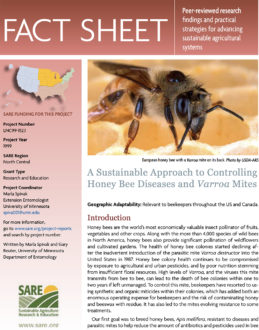We are not alone in our efforts to select honey bees for resistance to Varroa mites. Researchers at the USDA-ARS Honey Bee Breeding, Genetics and Physiology Lab in Baton Rouge, La., have bred and are maintaining several stocks of bees that have demonstrated resistance to Varroa. One of these stocks is called VSH, which stands for Varroa Sensitive Hygiene.
The VSH stock excels at detecting, uncapping and removing mite-infested brood, but interestingly, this hygienic behavior was not selected for using the assay we describe below.
The VSH stock was selected using three criteria:
- Colonies with a low rate of mite population growth over the season
- Colonies that actively removed mite-infested brood
- Colonies in which the mites had low reproductive success on worker pupae (Harbo and Hoopingarner, 1997; Harbo and Harris, 1999, 2005).
These selection steps require more time and detailed measurements than are feasible for most commercial beekeepers. We caution here that although the tests for hygienic behavior described below are quick, they will not necessarily lead to the same degree of resistance demonstrated by VSH stocks. The good news is that new selection assays are currently being developed to help beekeepers select resistant stocks more efficiently and effectively.
